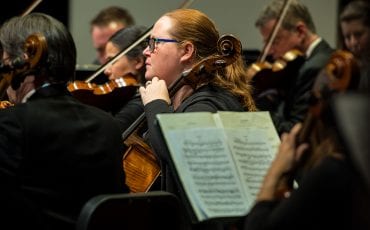Three Businesses Inspired by Kids With Special Needs

We Rock the Spectrum
As parents of children with special needs, these three business owners saw a need in the metro Atlanta community. They were inspired by their children to find solutions and provide special opportunities to help others. Learn what they can offer your family.
Table of Contents
Time to Play
Angela Erisman and her husband, Jeff, moved to metro Atlanta a year and a half ago from Tampa, Florida. Both of Erisman’s children, Grant and Coop, are on the autism spectrum. In Florida, they had access to We Rock the Spectrum gyms and were surprised to find there wasn’t anything for their kids that was safe and fun for them in Atlanta. “We wanted a concept that would be good for our kids and all kids, regardless of abilities, and that was safe and fun for kids with special needs and neurotypical kids,” she says. They became the first owners of a We Rock the Spectrum franchise in Georgia.
At the gym, there are sensory swings, and some equipment has been designed to help children self-regulate, develop motor skills or build muscle. The gym has a respite program called We Rock Care, where children can be dropped off. “Many families don’t have the ability to go anywhere without their kids, or they don’t have someone trained to watch them. We offer that service here,” she says. It’s also a service she knows is needed as the parent of children with special needs. “I can’t go into Target with both of my kids. Parents don’t always have options, but we change that.”
In the future, they hope to add classes, as well as open another gym in the Atlanta city limits.
The gym prides itself on being inclusive. “We’re combined in the world. It gives an earlier start for children with special needs and neurotypical children to learn to work together, grow together,” Erisman says. Families also have both neurotypical and children with special needs, and they can’t go somewhere together and have to separate them. You don’t have to do that here.”
With the pandemic, it has been difficult for Erisman to get the word out about the opening. Right now, families sign up for a time to play, and the gym is fully sanitized in between appointments. All adults and employees wear masks.

AG Educational Group
A Place to Learn
This school year, Alysa Armstrong-Gibbs’ son, Kashiim, was set to attend public high school, which would have been his first time back in a traditional brick-and-mortar school after five years of homeschool. But when reading Facebook posts and talking to families convinced her virtual learning was not a fit for her son with special needs, she stepped up to create the AG Educational Group Learning Café.
“It was out of necessity,” she says. “My son needed a place to learn and have access to other students. Children have a quiet space and supervision to complete their virtual learning. We offer access to resources, classes and training that help parents.” As an educator, Armstrong-Gibbs has created a multipurpose space for kids of all abilities with tutoring services, classes and workshops. If a child needs therapeutic services, the therapist can come into the space to use it. “We’re a small space, but we have the freedom and flexibility to cater to children’s needs,” she says.
Soon, she hopes to start homeschool classes. As a former classroom teacher and Master IEP Coach, Armstrong-Gibbs would assess each student and design a curriculum specific to them. “It would be different for each child, as no one size fits all,” she says. “Being the parent of a child with special needs is the driving force of what I do.” When designing the center, children’s needs were considered. They don’t use overhead lighting, they have soft surfaces, and children can sit on the floor, on rugs or on beanbags. “It’s not a traditional classroom, and we’re not trying to recreate the classroom,” she says.
The center is fully inclusive, so kids with special needs and neurotypical children interact. “Everybody helps everybody. Children with a label can still help the gifted child. Helping each other and inclusion naturally happens here,” she says. The center started as crisis schooling to fill a need, but COVID-19 has also been the biggest challenge to its success. “Parents are desperately asking for it, but they’re also afraid to put their child in a situation where they may contract COVID. We have very strict guidelines, and kids know and follow the guidelines,” she says. It’s a safe space, not only health-wise, but also emotionally for their cognitive and academic development.”
Starting in mid-November, they plan to offer free reading services.

Sensory Room Solutions
Feel at Home
Jay Perkins designs and installs sensory rooms in schools, churches and homes with his company, Sensory Room Solutions. These rooms help children with special needs calm down, self-regulate and relieve anxiety.
Perkins’ daughter, Jennifer, now 19, has been affected by sensory experiences from a young age. “Her needs very early on were sensory driven. Anything that could trigger her senses – smell, sights, temperature, texture – could trigger her negative behavior, which could manifest itself in aggression or self-injuries,” he says. “She was introduced to sensory rooms at Atlanta Speech School, and I saw firsthand how much that affected Jennifer from a positive aspect.”
Most of the work Perkins does is in schools. Schools budget for these rooms, which can take six to nine months to complete. For most schools, budgets are an issue. “If there’s anything left over, it’s spent on kids with special needs. Right now, there’s nothing left over, so they are left behind,” he says.
Perkins was also the founder of Sensations TheraFun, so he has seen the special needs industry change in Atlanta. “We were on the forefront of these sensory-based gyms and rooms, which have become more accepted,” he says. “Ten years ago, it was not as well known. Now, a lot of the educators know what they are and know the benefits.
As the parent of a child with special needs, Perkins brings his own experience to designing a sensory room. Schools might be concerned with the safety of the room, or they think the items will easily be destroyed. “I can say, ‘My daughter has given it her all and has not been able to destroy this stuff,’” he says. “My experience has taken me to the manufacturers who build industrial strength materials that will withstand a child’s destructive tendencies.”
Perkins also installs sensory rooms in churches. Because of Jennifer’s challenges, they couldn’t go together as a family. Instead, one parent would stay at home, while the other would take their other two kids to church. “When you offer services to a child with special needs, the whole family comes together to worship and build community,” he says.
If you’re interested in creating a sensory room or area for your child at home, Perkins suggests installing a bubble tube, a fish tank, color-changing fiber optics or shag carpet. “Get creative thinking about sensory input,” he says. “There’s tactile stuff out there. You don’t have to buy a $2,000 object when you can get the $200 object off of Amazon. I don’t have to do your room to have a conversation.”
What Parents of Children with Special Needs Want You to Know
Children with special needs are capable.
Armstrong-Gibbs: There is a misconception that children with special needs are not capable. This is not true. They will let you know what they need, and they can make accommodations for themselves. If you overly provide for them, you’re robbing them of the opportunity to learn and self-advocate. Presume competence 100% of the time, and if they need it, then provide them help.
Children with special needs want to be included.
Armstrong-Gibbs: Our kids are underestimated time and time again. They’re undervalued. The way the school system is set up – that’s not true inclusion. Neurotypical children learn these children are very different, because they only belong in this classroom or on this hallway. When they see each other at the park or library, they don’t interact. Everybody needs to have a sense of belonging on every level.
Erisman: Parents or kids think that kids with autism don’t want any friends, because they’re nonverbal or they’re in their own world. That’s not true – they just don’t know how to make friends. They want to be included, not just present in the same place. Kids with special needs have a lot to offer; they just have a unique way of showing it.
Be understanding.
Erisman: Parents think, “I don’t have kids with special needs, so I don’t need to know much about it.” Many children are affected by some condition or another, so it helps to be understanding or accepting of it. These journeys aren’t easy for parents or kids, which makes kindness, understanding and acceptance so important.
Perkins: When something happens to someone in the community, people jump in to help and bring casseroles or food. As a special needs family, we’re always close to a crisis. People don’t recognize that. What would matter a lot is having a friend drop off a casserole out of the blue or take the special needs child out, not because someone has asked. You just do it.
Be open to meeting people with special needs.
Perkins: If you hang around kids with special needs, you’re going to love the experience. It can be difficult, but it offers a glimpse into a world people don’t get to experience, and you’ll never forget it. Jennifer has behavioral challenges, and she can be violent. But that’s only about 10% of her world. I hope people see the 90% of her that’s loving, caring, intuitive – she’s got a great sense of humor. People stare at her, and she knows when they are. I want people to take the next step with greeting her by a smile or a wave.







